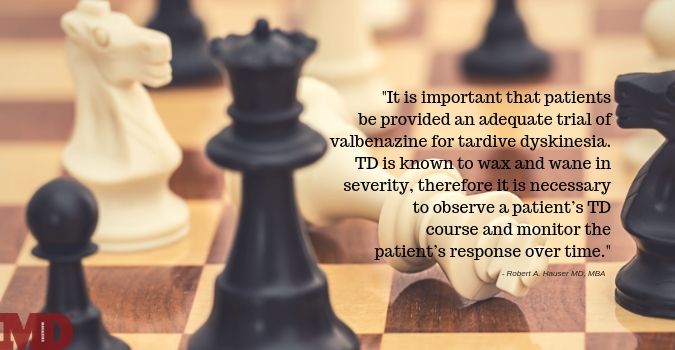Article
The Evolution of Valbenazine in Treating Tardive Dyskinesia
Author(s):
With a recent FDA approval as the first ever therapy for TD, as well as the first ongoing phase 4 clinical trial, valbenazine use is under close watch by clinicians and specialists.
is an iatrogenic hyperkinetic movement disorder arising from chronic treatment with antipsychotics, agents that reduce dopaminergic transmission. Its pathophysiology is associated with extended blockade of postsynaptic dopamine receptors with resultant dopamine hypersensitivity. Subsequent damage occurs to gamma-aminobutyric acid and cholinergic neurons with potential for oxidative damage in the striatum.
Both first- and second-generation antipsychotics have the same primary mechanism of action—to block D2 receptors—with aripiprazole acting through partial agonism. Until 2017, the American Academy of Neurology had recommended amantadine, ginkgo biloba,and clonazepam for the treatment of TD.[1]
The pharmacology of antipsychotics relies upon the theory that negative and cognitive symptoms in schizophrenia are due to dysfunction in the mesocortical pathway, and that overactivation of the dopamine mesolimbic pathway is related to positive symptoms such as delusions and hallucinations. Stephen Stahl’s “Dopamine Hypothesis of [Positive Symptoms of] Schizophrenia” suggests that antipsychotic manifestations are governed by postsynaptic dopamine antagonism.[2]
The reasons for this hypothesis, and the evidence to substantiate it, are that drugs such as cocaine and amphetamines are associated with high risk of psychosis due to their synaptic dopamine availability. The hypothesis is not without its well-known limitations, particularly in accounting for the presence of cognitive deficits in people with schizophrenia.
Conventional or first-generation antipsychotics act to reduce neurotransmission in the four dopamine pathways as D2 antagonists, potentially blocking other receptors (histamine-1, muscarinic-1, alpha-1). The key difference between the conventional antipsychotics and atypical or second-generation antipsychotics are that the latter are serotonin-dopamine antagonists, which are thought to improve negative and cognitive symptoms and reducing risk of extrapyramidal symptoms.
But in order to be “safe” from extrapyramidal side effects, it has been proposed that optimal dosing of any antipsychotic agent should be between 60% to 75% of D2 receptors.[3]
Vesicular monoamine transporter 2 (VMAT2) inhibitors are a class of drug that act to deplete dopamine at presynaptic striatal nerve terminals and have long been used to treat hyperkinetic movement disorders like TD. Of the 3 VMAT2 inhibitors that have recently become commercially available, deutetrabenazine and valbenazine have demonstrated safety and efficacy in the treatment of TD. Valbenazine, a purified metabolite of tetrabenazine, was approved by the US Food and Drug Administration (FDA) in April 2017.
Its mechanism of action is the increase of cytosolic dopamine levels and a decrease in synaptic dopamine release and post-synaptic receptor stimulation, which has the result of decreasing dyskinesia.[4] Valbenazine was the subject of the 6-week KINECT-3 randomized, double-blind, placebo-controlled trial to examine the drug’s efficacy and tolerability.[5] Findings from the trial included Abnormal Involuntary Movement Scale (AIMS) scores that remained virtually unchanged in the placebo group at a mean of -0.1 units, with a significantly greater decrease observed in the active treatment groups at means of -1.9 units and -3.2 units in the 40mg/day group and the 80mg/day group, respectively.[6] The investigators concluded that the daily dose of 80mg/day was statistically significant compared to placebo.
“I think that the way that the medication works, to a certain extent, depends on disease severity, but also with that class of medications, it depends on how patients metabolize the drug,” Joohi Jimenez-Shahed, MD, co-author of “VMAT2 Inhibitors in Neuropsychiatric Disorders” and Associate Professor of Neurology at Baylor College of Medicine told MD Magazine®. “For instance, if they have a certain kind of high metabolizer status, then they might require higher dosage in order to get the same benefit. If their metabolism is slow, then maybe they cannot go beyond a certain dosage if they’re having problems with the medication.
Jimenez-Shahed added that, as a class of medication, there is always a recognition of response variability. But she doesn't think that's necessarily something clinicians have a firm understanding on yet.
"It’s not clearly predictable exactly how to approach the patient and that’s why you just have to start somewhere, observe how they’re doing, and consider either a higher dose or a different therapy if they’re not responding to valbenazine," he explained. "I think the important part is that they were allowed to stay on the antipsychotics while taking the valbenazine.”
Jimenez-Shahed, who also serves as Associate Director of the Neurology Residency Program and Director of Deep Brain Stimulator Program at Baylor, noted that it seems unlikely that the antipsychotic taken by the patient has an effect on their response to valbenazine.
“I don’t think there is any evidence that people on different types (whether older-generation versus newer-generation of antipsychotics) had a different response [to valbenazine],” she said.
Investigators in the KINECT-3 study found few treatment-emergent adverse events as a result of valbenazine dosing of 40mg and 80mg over their 6-week trial. The most common adverse events in both treatment groups as well as the placebo group were somnolence (5.3% and 3.9%, respectively), akathisia (3.3% and 1.3%, respectively), and dry mouth (3.3% and 1.3%, respectively). Suicidal ideation was the most common in the placebo group (5.3%, compared with 2.6% in the valbenazine groups combined). In a separate study, researchers from Neurocrine Biosciences found that valbenazine did not add to the cardiovascular risks associated with schizophrenia.
“It is important that patients be provided an adequate trial of valbenazine for TD,” KINECT-3 principal investigator Robert A. Hauser MD, MBA, Professor of Neurology and Director, Byrd Parkinson’s Disease and Movement Disorders Center, Parkinson Foundation Center of Excellence at the University of South Florida, told MD Mag. “TD is known to wax and wane in severity, therefore it is necessary to observe a patient’s TD course and monitor the patient’s response over time. The valbenazine label recommends that patients be started at 40 mg daily for one week and then increase to 80 mg daily. However, 40 mg daily may be adequate for some patients. In addition, if side effects occur on the 80 mg/day dose, the dose can be reduced to 40 mg/day. It is also important to note that valbenazine can be added to background psychiatric therapies and can be taken with or without food.”
Findings from the KINECT-3 trial can inform future studies into effective treatment of TD to develop baseline characteristics of patients who may respond best to treatment compared to nonresponders and adverse event profiles, and maintenance strategies, as well as phenomenology and course of tardive dyskinesia itself.
“KINECT-3 itself was not powered to detect differences in efficacy across subgroups,” said Hauser. “However, based on analyses of pooled data from multiple studies, there does not seem to be a pattern as to what patient types respond best nor were clearly non-responding subgroups identified. Treatment with valbenazine generally resulted in clinically meaningful improvement across different baseline subgroups (age, sex, diagnosis, TD duration, concomitant psychiatric medication type, BMI, etc.).”
No study has yet been performed to specifically evaluate clinical remission with valbenazine. “In both the blinded, long-term extension of KINECT-3 and the open-label, long-term KINECT-4 when participants stopped taking valbenazine at the end of the studies mean Abnormal Involuntary Movement Scale (AIMS) scores returned toward baseline over the 2-week period post-dosing. Of note, there was no evidence of rebound in the clinical symptoms of TD following withdrawal of valbenazine dosing in KINECT-3 and KINECT-4.”
In a poster presentation at the 2018 International Congress of Parkinson's Disease and Movement Disorders held in Hong Kong on October 6, KINECT-3 or KINECT-4 participants taking once-daily valbenazine were reported to have high satisfaction rates.[7] Based on a Patient Satisfaction Questionnaire (PSQ), satisfaction was reported even by patients treated with valbenazine for up to 2 years.
A clinical trial for which Neurocrine is currently in the recruiting phase, the “Phase 4, Randomized, Double-Blind, Placebo-Controlled Study to Evaluate the Potential for Clinical Dependence and Withdrawal Symptoms Associated with Valbenazine,” got underway on September 14, 2018, with an estimated study completion date of April 2019.
[1] Bhidayasiri R, Jitkritsadakul O, Friedman JH, Fahn S. Updating the recommendations for treatment of tardive syndromes: A systematic review of new evidence and practical treatment algorithm. Journal of the Neurological Sciences. 2018;389:67-75. doi:10.1016/j.jns.2018.02.010
[2] Sandler M. The dopamine hypothesis revisited. The Biological Basis of Schizophrenia. 1978:79-85. doi:10.1007/978-94-011-6206-7_7
[3] Kapur S, Seeman P. Does fast dissociation from the dopamine d(2) receptor explain the action of atypical antipsychotics?: A new hypothesis. Am J Psychiatry. 2001;158(3):360- 9 

[4] Citrome L. Tardive dyskinesia: placing vesicular monoamine transporter type 2 (VMAT2) inhibitors into clinical perspective. Expert Review of Neurotherapeutics. 2018;18(4):323-332. doi:10.1080/14737175.2018.1455504
[5] Hauser RA, Factor SA, Marder SR, et al. KINECT 3: A Phase 3 Randomized, Double-Blind, Placebo-Controlled Trial of Valbenazine for Tardive Dyskinesia. American Journal of Psychiatry. 2017;174(5):476-484. doi:10.1176/appi.ajp.2017.16091037
[6] Valbenazine shows efficacy for tardive dyskinesia in phase III trial. Clinical Pharmacist. 2017. doi:10.1211/cp.2017.20202743
[7] S. Lessig, S. Marder, C. Verghese, J. Burke, R. Jimenez, S. Siegert, G. Liang. Global Improvement and Patient Satisfaction: Results from a Long-Term, Open-Label, Rollover Study of Valbenazine in Tardive Dyskinesia [abstract]. Mov Disord.2018; 33 (suppl 2). http://www.mdsabstracts.org/abstract/global-improvement-and-patient-satisfaction-results-from-a-long-term-open-label-rollover-study-of-valbenazine-in-tardive-dyskinesia/. Accessed October 24, 2018.
During the trial, patients with clinically significant unstable medication within one month prior to screening who are naïve to valbenazine will be subjected to 7 weeks of valbenazine administration or placebo, with the primary outcome measure of the number of participants with withdrawal-related adverse events. Overall improvement of TD symptoms, measured by the clinical global impression-TD-improvement scale, will also be observed.





